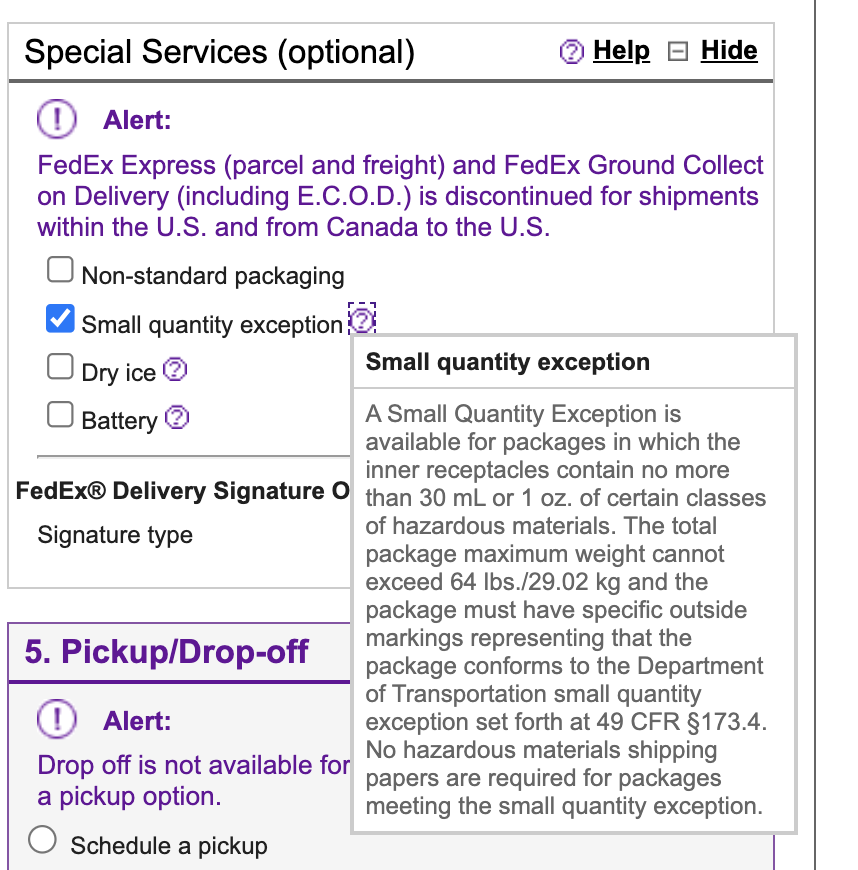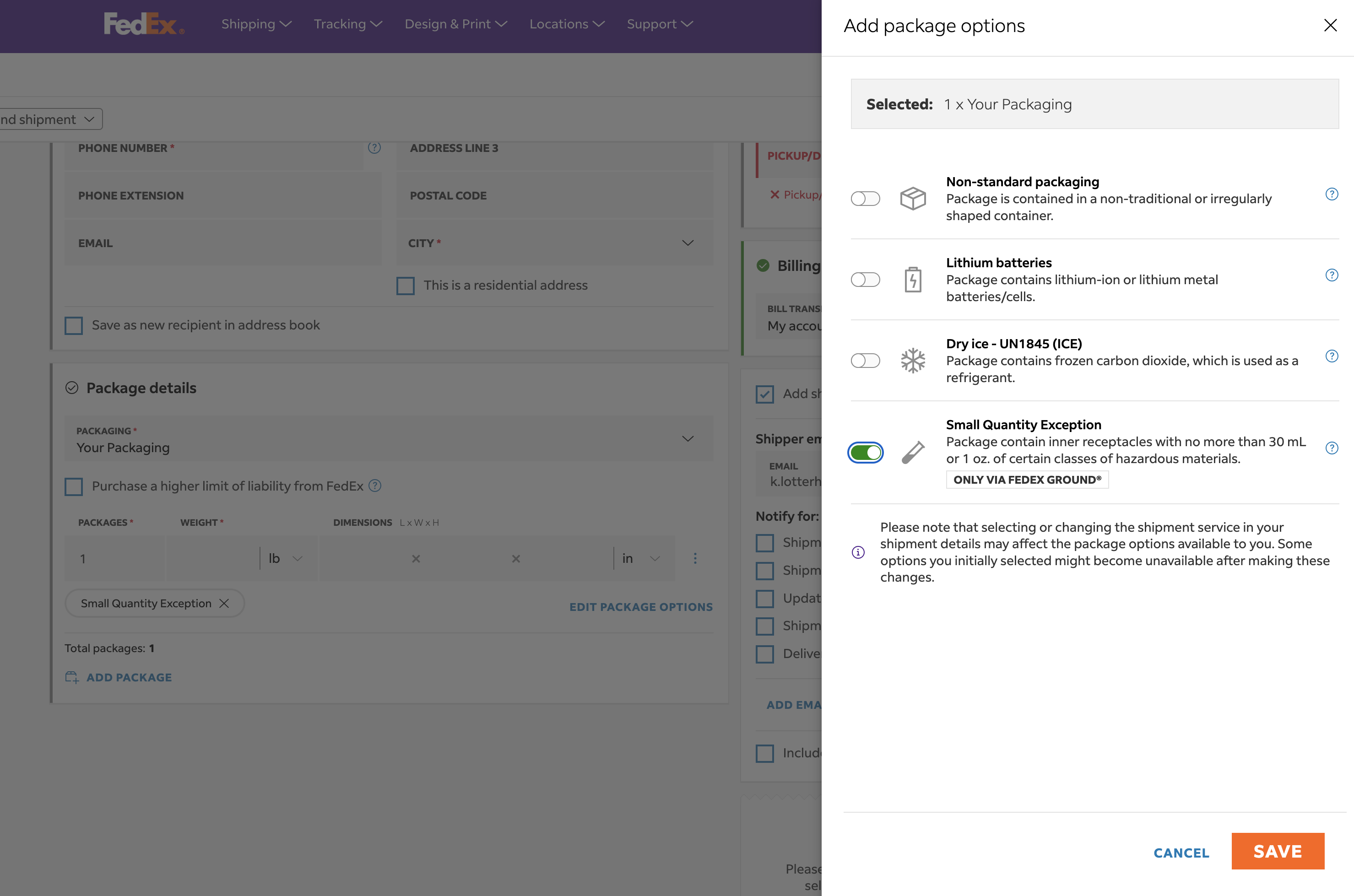Shipping of Hazardous Materials
This is applicable in cases when hazardous materials are shipped in ‘small quantity’. Double-check with NU’s Environmental and Health Safety (EHS) what volume is considered ‘small quantity’ before deciding that your shipment qualifies as excepted quantities.
Example: sample vials with 95% ethanol – up to 100 mL (total ethanol volume).
Packing the materials
The primary container(s), e.g. ethanol vials, must be leak-proof and allow space for liquid expansion,
If shipping multiple vials, use a grid box or rack to stabilize them,
Primary containers must be placed inside a secondary container (e.g., a ziplock bag) filled with enough appropriate absorbert material (e.g., paper towels) in case primary container spills.
What Northeastern’s EHS needs from you
Northeastern University, Hazardous Material Shipping Declaration Form, filled out and signed,
A statement that the package contents qualify as hazardous goods in excepted quantities,
A letter informing the (1) package contents, (2) name and location of the person receiving the package and (3) your (the shipper’s) name, contact info (phone and address) and job title.
I incorporated b) into c) for brevity.
Then make a pdf file of these documents combined and email to EHS: biosafety@northeastern.edu and to lab manager
Example of the combined letter/statement:
To whom it may concern,
This package is intended for Dr. Jane Smith, in San Diego, CA. Inside this package you will find 1 grid box with 50 vials containing 1.9 mL of ethanol each at 95% concentration (total volume of ethanol in the package is 95 mL).
The content of this package qualifies as “Dangerous Goods in Excepted Quantities”.
If you have any questions regarding this package, please contact Dr. Thais Bittar at 781-581-XXXX or t.bittar@northeastern.edu
Best regards,
T. Bittar, Lotterhos Lab Manager, Northeastern UniversityPacking the shipping box
Do not use FedEx boxes, envelopes, sleeves or other non-rigid mailers for liquids; you will need a sturdy container, such as a cardboard box, that is at least 100 x 100 mm or 4 x 4 in.
What goes inside the box
Your packed vials
MSDS, if applicable (for ethanol, in this example)
A copy of the letter/statement listed items 2 b) and 2 c)
What goes on the outside of the box
- The “Dangerous Goods in Excepted Quantity” label
Must be at least 100 x 100 mm or 4 x 4 in
Must conform with shape, color, format and text of the official label (see lab manager)
Must be filled out with DOT hazmat class and your full name (class 3 for DOT for flammable ignitable liquids in this example; see lab manager)
- The shipping label (from FedEx, UPS, etc) – you do not need to inform the carrier that you are shipping hazmats as long as the package is labeled correctly (see front desk associate to create shipping label and schedule pickup)
Hazardous shipping laws for small quanitities
This law covers hazardous shipping:
https://www.ecfr.gov/current/title-49/subtitle-B/chapter-I/subchapter-C
The law for small quantity exception is described here:
https://www.ecfr.gov/current/title-49/subtitle-B/chapter-I/subchapter-C/part-173/subpart-A/section-173.4
A flammable liquid is Class 3 (https://www.ecfr.gov/current/title-49/subtitle-B/chapter-I/subchapter-C/part-173/subpart-D/section-173.120)
Basically, if each inner receptical holds less than 30mL and the total box weight is less than 64 pounds, we can ship small quantity exception. To do so, the package has to be shipped GROUND and the package has to be clearly labeled as described below.
In Fed Ex make sure to click the “small quantity exception” box.
In the legacy editor:

In the new editor:

Make sure to use GROUND shipping. For ethanol make sure there is less than 5 L total across al the vials.
On the outside of the box include the following label for small quantity exception:

On the outside of the box in a sleeve and on the inside of the box include the following letter:
This package contains individual oyster tissue samples for research stored in
vials with 1-2mL 95% ethanol. Each vial has an o-ring to prevent leakage.
This package conforms to 49 CFR 173.4 for domestic highway or rail transport
only.
<add your contact information>